Discover 25 hidden attractions, cool sights, and unusual things to do in Armenia. Don't miss out on these must-see attractions: Tsitsernakaberd (Yerevan), Matenadaran (Yerevan) or National Gallery of Armenia (Yerevan).
Below, you can find the list of the most amazing places you should visit in Armenia.
Table of Contents
Tsitsernakaberd, Yerevan

Also known as: Հայոց ցեղասպանության զոհերի հուշահամալիր
Monument in Yerevan, Armenia. The Armenian Genocide Memorial complex is Armenia's official memorial dedicated to the victims of the Armenian genocide, built in 1967 on the hill of Tsitsernakaberd in Yerevan. Every year on 24 April, the Armenian Genocide Remembrance Day, thousands of Armenians gather at the memorial to commemorate the victims of the genocide. The people who gather in Tsiternakaberd lay fresh flowers out of respect for all the people who died in the Armenian genocide. Over the years, from around the world, a wide range of politicians, artists, musician, athletes, and religious figures have visited the memorial.
The Armenian Genocide Museum-Institute (Հայոց ցեղասպանության թանգարան-ինստիտուտ Hayots tseghaspanut'yan tangaran-institut) was opened in 1995.[1]
Address: Tsitsernakaberd Hwy, Yerevan
Matenadaran, Yerevan

Also known as: Մատենադարան
Institute and exhibitor of rare documents. The Matenadaran, officially the Mesrop Mashtots Institute of Ancient Manuscripts, is a museum, repository of manuscripts, and a research institute in Yerevan, Armenia. It is the world's largest repository of Armenian manuscripts.
It was established in 1959 on the basis of the nationalized collection of the Armenian Church, formerly held at Etchmiadzin. Its collection has gradually risen since its establishment, mostly from individual donations. One of the most prominent landmarks of Yerevan, it is named after Mesrop Mashtots, the inventor of the Armenian alphabet, whose statue stands in front of the building.[2]
Address: 53 Mashtots Avenue, 0009 Yerevan
National Gallery of Armenia, Yerevan
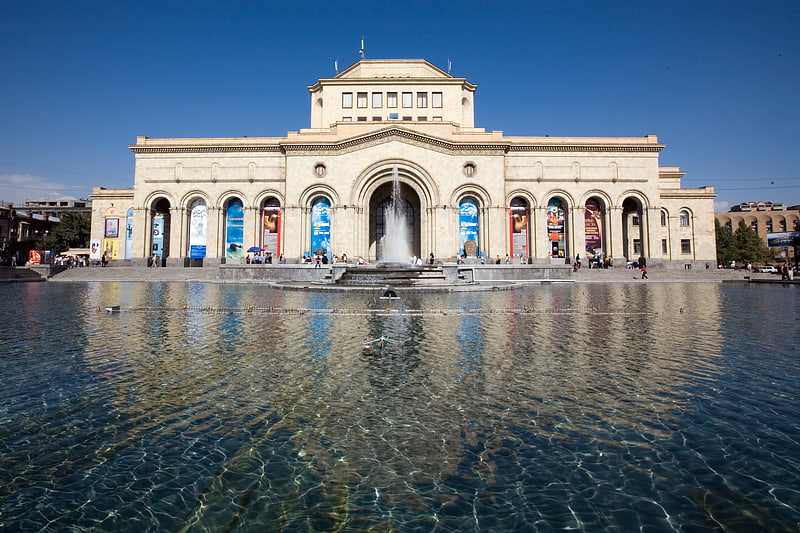
Also known as: Հայաստանի ազգային պատկերասրահ
Art museum with modern and historic works. The National Gallery of Armenia is the largest art museum in Armenia. Located on Yerevan's Republic Square, the museum has one of the most prominent locations in the Armenian capital. The NGA houses significant collections of Russian and Western European art, and the world's largest collection of Armenian art. The museum had 65,000 visitors in 2005.[3]
Address: 1 Aram Street, 0010 Yerevan
Etchmiadzin Cathedral, Vagharshapat
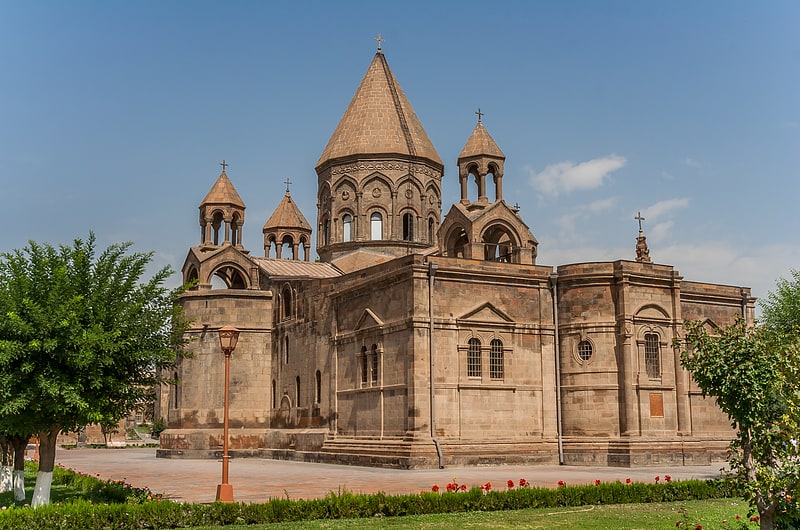
Also known as: Էջմիածնի Մայր Տաճար
Church in Vagharshapat, Armenia. Etchmiadzin Cathedral is the mother church of the Armenian Apostolic Church, located in the city of Vagharshapat, Armenia. According to most scholars it was the first cathedral built in ancient Armenia, and is often considered the oldest cathedral in the world.
The original church was built in the early fourth century—between 301 and 303 according to tradition—by Armenia's patron saint Gregory the Illuminator, following the adoption of Christianity as a state religion by King Tiridates III. It was built over a pagan temple, symbolizing the conversion from paganism to Christianity. The core of the current building was built in 483/4 by Vahan Mamikonian after the cathedral was severely damaged in a Persian invasion. From its foundation until the second half of the fifth century, Etchmiadzin was the seat of the Catholicos, the supreme head of the Armenian Church.
Although never losing its significance, the cathedral subsequently suffered centuries of virtual neglect. In 1441 it was restored as catholicosate and remains as such to this day. Since then the Mother See of Holy Etchmiadzin has been the administrative headquarters of the Armenian Church. Etchmiadzin was plundered by Shah Abbas I of Persia in 1604, when relics and stones were taken out of the cathedral to New Julfa in an effort to undermine Armenians' attachment to their land. Since then the cathedral has undergone a number of renovations. Belfries were added in the latter half of the seventeenth century and in 1868 a sacristy was constructed at the cathedral's east end. Today, it incorporates styles of different periods of Armenian architecture. Diminished during the early Soviet period, Etchmiadzin revived again in the second half of the twentieth century, and under independent Armenia.
As the main shrine of Armenian Christians worldwide, Etchmiadzin has been an important location in Armenia not only religiously, but also politically and culturally. A major pilgrimage site, it is one of the most visited places in the country. Along with several important early medieval churches located nearby, the cathedral was listed as a World Heritage Site by UNESCO in 2000.[4]
Garni Temple, Garni

Also known as: Գառնու հեթանոսական տաճար
Colonnaded temple from the 1st century. The Temple of Garni is the only standing Greco-Roman colonnaded building in Armenia and the former Soviet Union. Built in the Ionic order, it is located in the village of Garni, in central Armenia. It is the best-known structure and symbol of pre-Christian Armenia.
The structure was probably built by king Tiridates I in the first century AD as a temple to the sun god Mihr. After Armenia's conversion to Christianity in the early fourth century, it was converted into a royal summer house of Khosrovidukht, the sister of Tiridates III. According to some scholars it was not a temple but a tomb and thus survived the destruction of pagan structures. It collapsed in a 1679 earthquake. Renewed interest in the 19th century led to excavations at the site in early and mid-20th century, and its eventual reconstruction between 1969 and 1975, using the anastylosis method. It is one of the main tourist attractions in Armenia and the central shrine of Hetanism (Armenian neopaganism).[5]
Address: Котайкская область, 2215 Garrni
Saint Hripsime Church, Vagharshapat
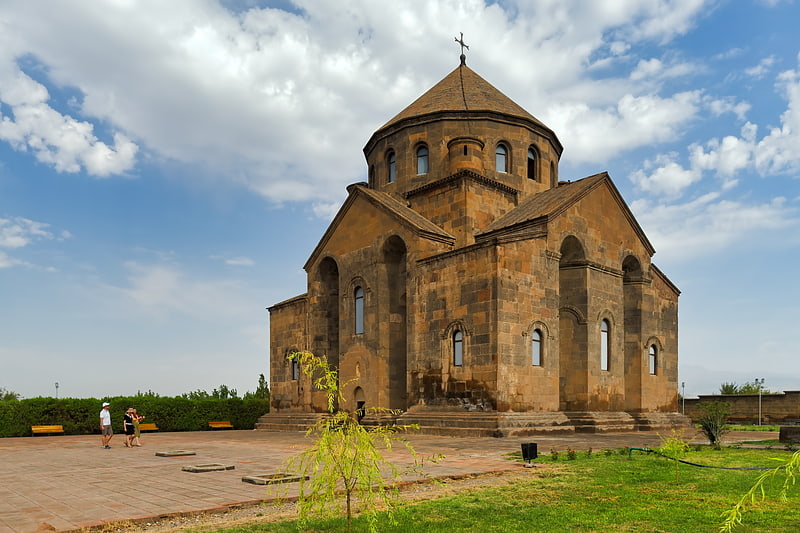
Also known as: Սուրբ Հռիփսիմե եկեղեցի
Circa 618 CE church with a bell tower. Saint Hripsime Church is a seventh century Armenian Apostolic church in the city of Vagharshapat, Armenia. It is one of the oldest surviving churches in the country. The church was erected by Catholicos Komitas to replace the original mausoleum built by Catholicos Sahak the Great in 395 AD that contained the remains of the martyred Saint Hripsime to whom the church is dedicated. The current structure was completed in 618 AD. It is known for its fine Armenian-style architecture of the classical period, which has influenced many other Armenian churches since. It was listed as a UNESCO World Heritage Site along with other nearby churches, including Etchmiadzin Cathedral, Armenia's mother church, in 2000.[6]
Address: 85 Mesrop Mashtots Street, Vagharshapat
Saint Gayane Church, Vagharshapat
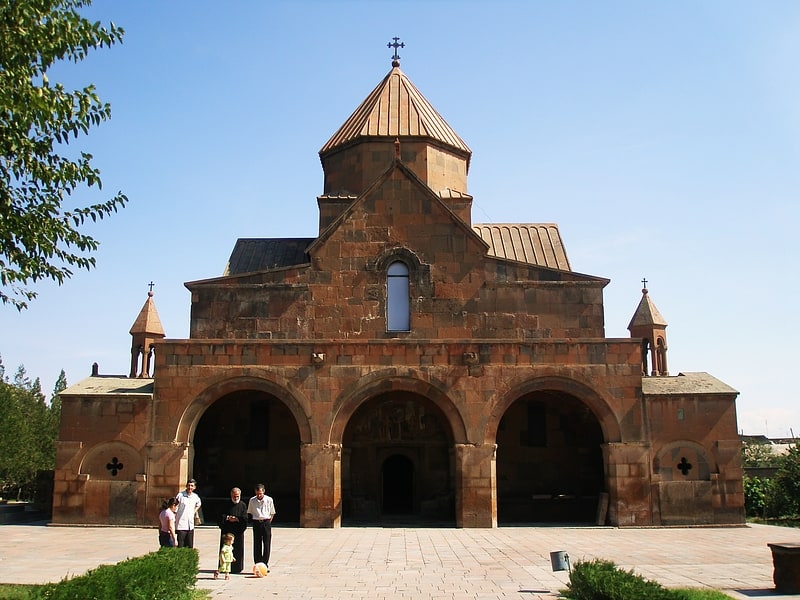
Also known as: Սուրբ Գայանե եկեղեցի
7th-century church named for a martyr. The Saint Gayane Church is a 7th-century Armenian church in Vagharshapat, the religious center of Armenia. It is located within walking distance from the Etchmiadzin Cathedral of 301. St. Gayane was built by Catholicos Ezra I in the year 630. Its design has remained unchanged despite partial renovations of the dome and some ceilings in 1652.
Gayane was the name of an abbess who was martyred with other nuns by Tiridates III of Armenia in the year 301, and subsequently made a saint of the Armenian Apostolic Church.
In 2000, Saint Gayane Church was listed in the UNESCO World Heritage Sites along with historical churches of Vagharshapat.[7]
Address: Issy-les-Moulineaux St., Vagharshapat
Lake Parz, Dilijan National Park
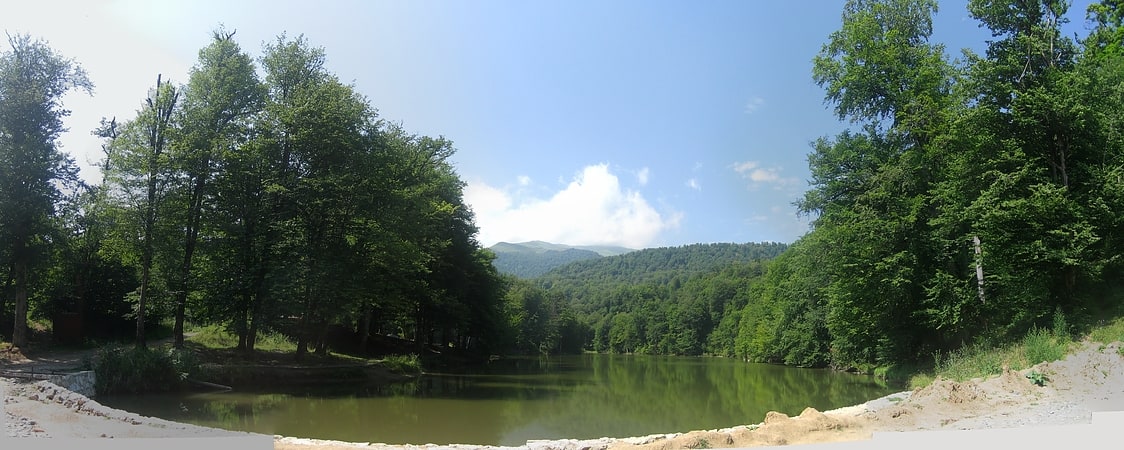
Also known as: Պարզ լիճ
Lake in Armenia. Lake Parz is a small lake located in the Dilijan National Park east of Dilijan in Armenia. The lake was formed by natural climatic changes. "Parz" in Armenian means clear.
In 2017 the TransCaucasian Trail was created to connect Parz Lake with the town of Dilijan and in the opposite direction with Gosh Village and Gosh Lake. The trail was created through the building of new trail segments to connect existing trails or dirt roads together.
In 2018 Trails For Change NGO has built a new trail that loops around the Lake.
A restaurant with bar, paddle boats ropes course and zip lines are found around the lake.[8]
Address: Dilijan National Park, Dilijan National Park
Sanahin Monastery, Alaverdi
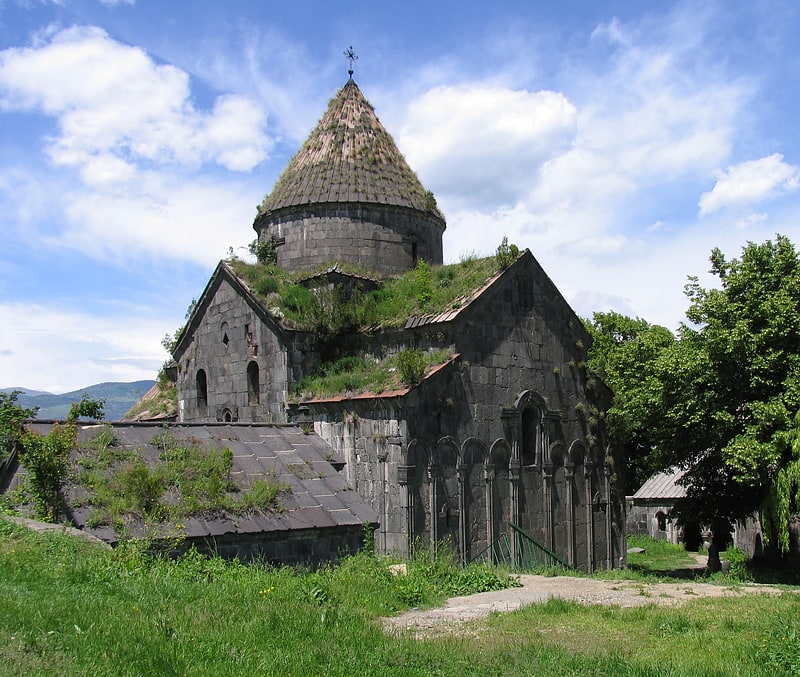
Also known as: Սանահինի վանական համալիր
Medieval monastery with ornate stonework. Sanahin Monastery is an Armenian monastery founded in the 10th century in the Lori Province of Armenia, recognized as a UNESCO World Heritage Site.
The name Sanahin literally translates from Armenian as 'this one is older than that one', presumably representing a claim to having an older monastery than the neighbouring Haghpat Monastery. The two villages and their monasteries are similar in many ways, and lie in plain view of each other on a dissected plateau formation, separated by a deep crack formed by a small river flowing into the Debed river.
As with Haghpat, Sanahin is frequented by an increasing number of tourists, due to its recent inclusion on the itineraries of a great number of Armenian tour agencies, the beauty of its monastery complex matching that of Haghpat's. The complex belongs to the Armenian Apostolic Church with numerous khachkars (stones with elaborate engravings representing a cross) and bishop gravesites scattered throughout it.[9]
Address: Sanahin Village, Alaverdi
Haghpat Monastery, Alaverdi
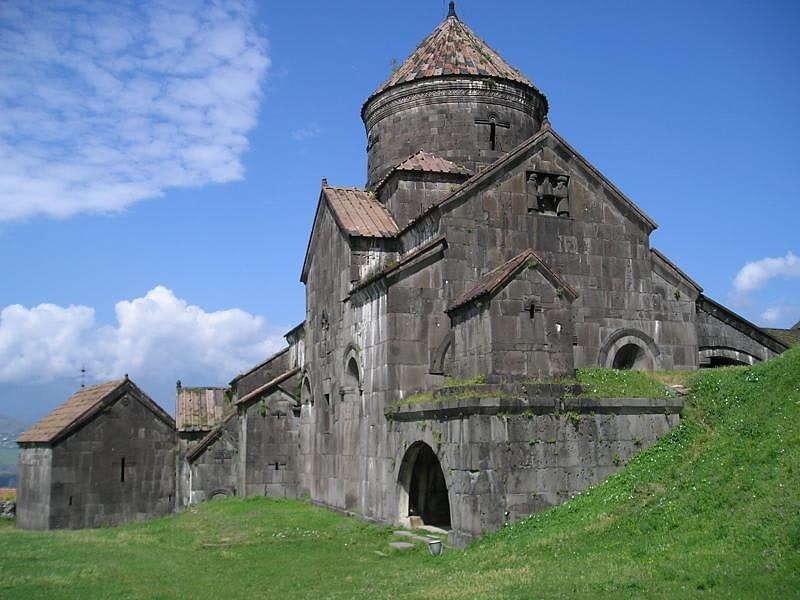
Also known as: Հաղպատի վանական համալիր
Monastery. Haghpat Monastery, also known as Haghpatavank, is a medieval monastery complex in Haghpat, Armenia, built between the 10th and 13th century.[10]
Address: Haghpat Village, Alaverdi
Hovhannes Shiraz House-Museum, Gyumri
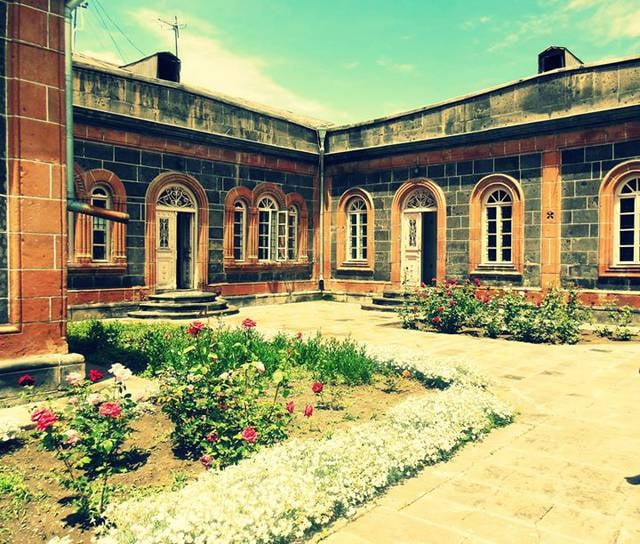
Museum in Gyumri, Armenia. The Hovhannes Shiraz House-Museum was founded in 1983 in the Kumayri historic district of Gyumri, Armenia, and opened in 2003. The museum is devoted to the exhibition and preservation of the Armenian poet Hovhannes Shiraz's personal belongings, manuscripts and works.
The building was built in 1886, with red tuff stone of the Shirak province, and was the home of a wealthy merchant named Qeshishyan. During most of the Soviet period, it was used as a storehouse. In July 1983, not wanting to wait until Shiraz's death to honour him, government officials offered Shiraz a home to live in. However, the poet only lived in this house for a year, as he died in March 1984.
In order to preserve his legacy, the building later became a house-museum by the resolution of the Government of Armenia. Due to the 1988 Armenian earthquake, the museum's refurbishment was interrupted, and 8 homeless families found shelter in the house.
The USAID Housing Purchase Certificate Program assisted to relocate displaced families living in the house after the earthquake to permanent housing. This permitted the museum, in collaboration with the Government of Armenia and the City Hall of Gyumri, to restore the public space as a house-museum.
Today, the western facade has a luxurious gate that leads to a large courtyard. The museum consists of six rooms. The first presents information about the poet's childhood. The second room is furnished as it was during Shiraz's lifetime. The other four rooms house the author's creative works, paintings, sculptures, etc. On display is a painting by the American author, John Steinbeck, thanking Shiraz for his hospitality in Yerevan.
The House-Museum is located on 101 Varpetats Street, Gyumri 3104, Armenia.[11]
Address: Shahumyan St and Gorki Street, Gyumri
Havuts Tar, Garni
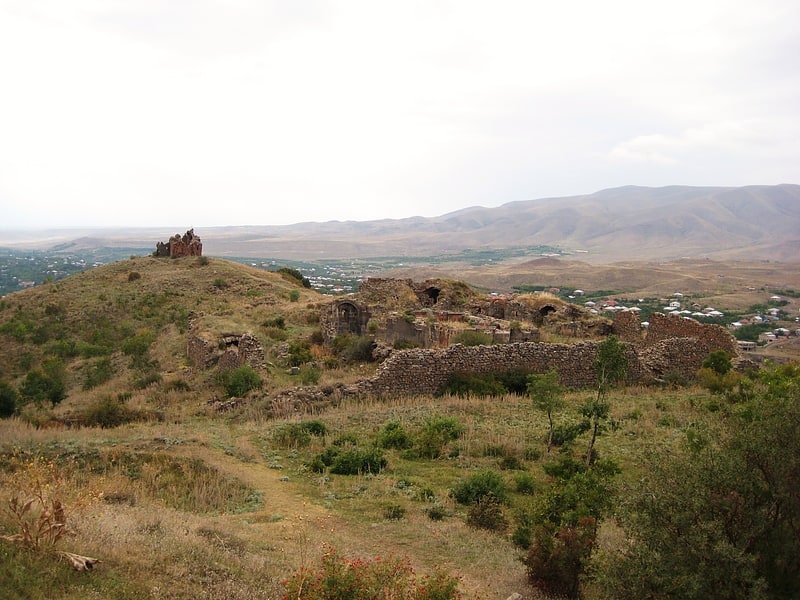
Also known as: Հավուց Թառի վանք
Monastery in Armenia. Havuts Tar is an 11th to 13th century walled monastery, situated upon a promontory along the Azat River Valley across from the villages of Goght and Garni in the Kotayk Province of Armenia. It is easily reached via the Khosrov State Reserve, located across the Garni Gorge. The Havuts Tar Trail leads directly from the east side of the reserve entrance to the monastic complex. An alternate route/shortcut to the monastery can be found at the end of the main road along the Azat River and just past the fish hatchery ponds.
It takes approximately thirty minutes to reach the ruins of the monastery via the Havuts Tar Trail. A couple of khachkars can be found midway along the trail as it forks left upon a very low mound. Also, a short distance from the monastery (clearly visible oh a hill in the background) in a small field to the left, is a large khachkar and a small ruined monument. Following the trail a little further leads to the fortified walls and ruins of the monastic complex. Just before entering the monastery, a small path leads up a hill to the east and through a semi-wooded area. At the end of the path are the ruins of a small chapel with two large khachkars to the left, and a third to the right.[12]
Mashtots Hayrapet Church of Garni, Garni
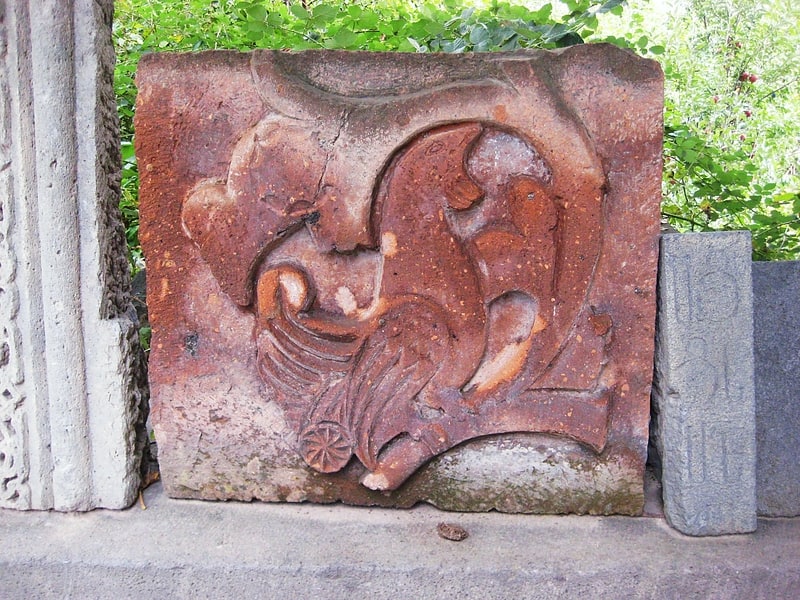
Also known as: Մաշտոց Հայրապետ եկեղեցի
Armenian church in Garni, Armenia. Mashtots Hayrapet is a church located within the village of Garni in the Kotayk Province of Armenia. It was built in the 12th century at the site of what was a pagan shrine. A stone carved from red tufa is situated at the right of the entrance upon a low rock wall. It has on it the design of a bird perched on a floral stem with the rosette of eternity under its tail. The rosette is also a distinctive pagan symbol representing the sun or the moon, symbolizing the eternal cycle of life, death, and rebirth. It is said that because of this pagan symbology, this stone has a connection to the prior shrine.
The church has a small cruciform type central-plan with a single drum and dome. It is constructed from dark grey stone, with red tufa inlaid around the windows, roof, and dome. Elaborate decorations of geometric and foliage patterns may be seen all around the windows, portal, dome, and other parts of the façade. The apron around the apse in the interior of the church also is intricately carved. A number of khachkars are scattered around the church grounds, including one in particular adjacent to the building that is reminiscent of a small shrine.
In the village is also the fortress complex of Garni with the 1st century AD Garni Temple, Surb Astvatsatsin Church, a ruined 4th century single-aisle church, a ruined Tukh Manuk Shrine, Saint Sargis Shrine, and a Queen Katranide Shrine. Across the Garni Gorge is the Havuts Tar Monastery and Aghjots Vank located in the Khosrov State Reserve.[13]
Gallery of Mariam and Eranuhi Aslamazyan Sisters, Gyumri
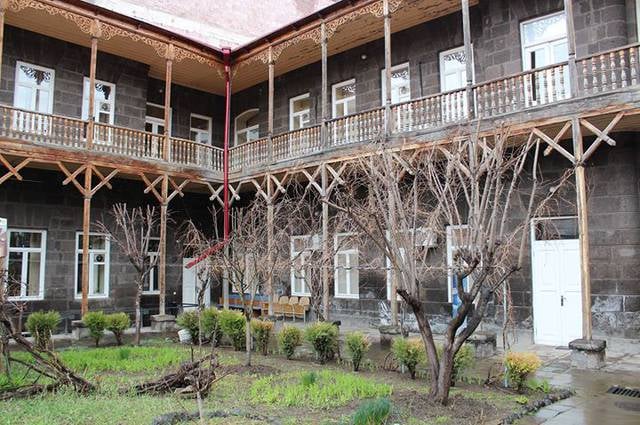
The Gallery of Mariam and Eranuhi Aslamazyan Sisters is a gallery in Armenia, exhibiting the complete collection of the painting, graphic, ceramic works of Mariam and Eranuhi Aslamazyan sisters. It holds the largest collection of the Aslamazyan sisters' paintings, prints, drawings, and ceramic works of any museum in the world. It is the only museum named after female artists and devoted to female artists in Armenia.[14]
Address: Abovyana St. 242, 3104 Gyumri
Statue of Avetik Isahakyan, Gyumri
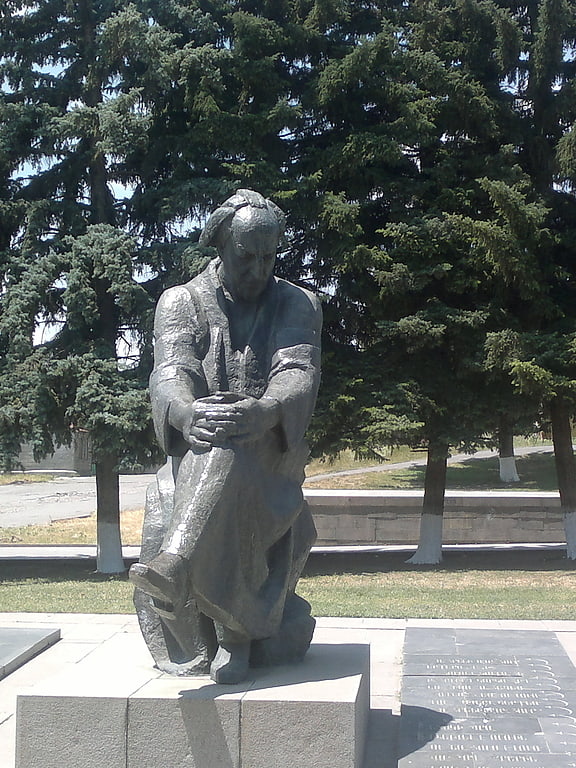
Historical landmark in Gyumri, Armenia. Statue of Avetik Isahakyan is a monumental statue. It is situated in front of the Gyumri theater in Gyumri theater square in Shirak Province, Armenia.[15]
Carahunge, Sisian
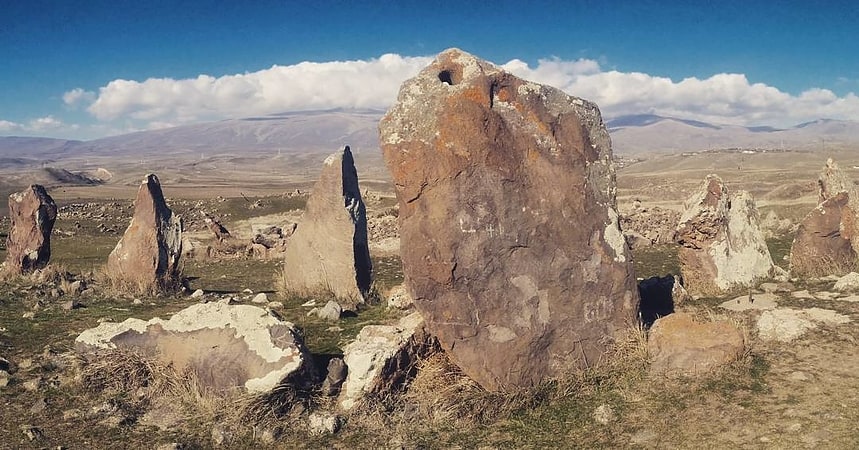
Also known as: Քարահունջ
Historical landmark in Sisian, Armenia. Carahunge, also known as Zorats Karer, Dik-Dik Karer, Tsits Karer and Karenish, is a prehistoric archaeological site near the town of Sisian in the Syunik Province of Armenia. It is also often referred to in international tourist lore as the "Armenian Stonehenge".[16]
Lake Kari, Byurakan

Also known as: Քարի լիճ
Lake in Armenia. Lake Kari is a lake in Armenia located on the slopes of Mount Aragats. Most of its water comes from ice and snow. It is located 3,185 m above the sea level and has a perimeter of 1,150 m. From Byurakan village an asphalt automobile road stretches towards the source of Arkashen River, the lake Kari, located on a plateau below the peaks. On the eastern side of the lake there is a meteorological station.[17]
Amberd, Byurakan

Also known as: Ամբերդ
Historical place in Armenia. Amberd is a 10th-century fortress located 2,300 meters above sea level, on the slopes of Mount Aragats at the confluence of the Arkashen and Amberd rivers in the province of Aragatsotn, Armenia. The name translates to "fortress in the clouds" in Armenian. It is also the name incorrectly attributed to Vahramashen Church, the 11th-century Armenian church near the castle. The village of Byurakan is 6.4 kilometres from the site of Amberd.[18]
Shaki Waterfall, Sisian
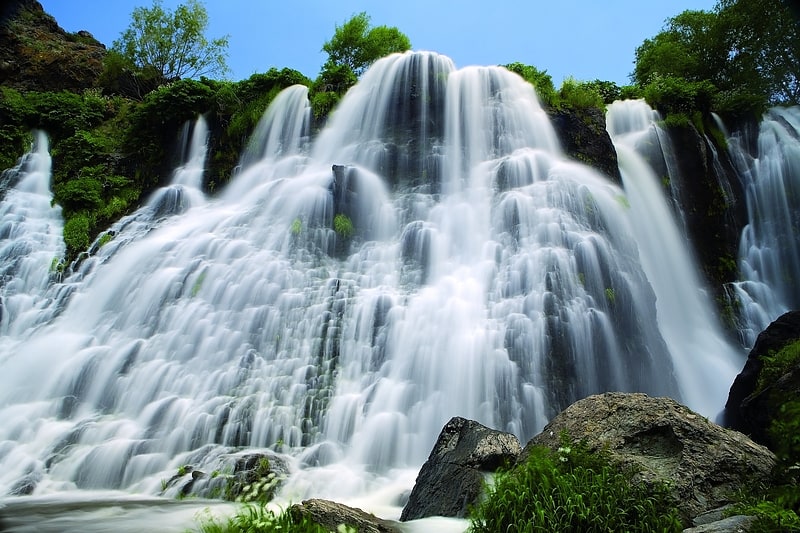
Also known as: Շաքիի ջրվեժ
Waterfall in Armenia. Shaki Waterfall is a waterfall in Armenia, with a height of 18 m. It is located in Syunik Province.
The Shaki Waterfall is situated 6 km from the town of Sisian. On the left side of the river Vorotan's gorge, basalt lava flows have solidified to form a ledge 18 meters high from which the waterfall cascades down.[19]
Aghavnavank Monastery, Dilijan National Park
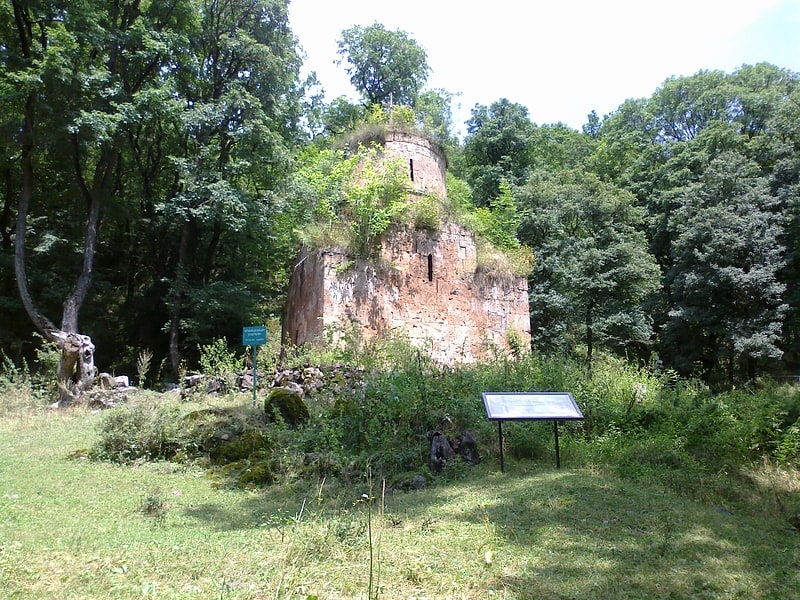
Also known as: Աղավնավանք
Monastery in Armenia. Aghavnavank Monastery is a 12th–13th century monastic complex at Dilijan National Park on the outskirts of Aghavnavank village of the Tavush Province of Armenia.[20]
Address: On the outskirts of Aghavnavank village, in Dilijan National Park, Dilijan National Park
Haghartsin Monastery, Dilijan National Park
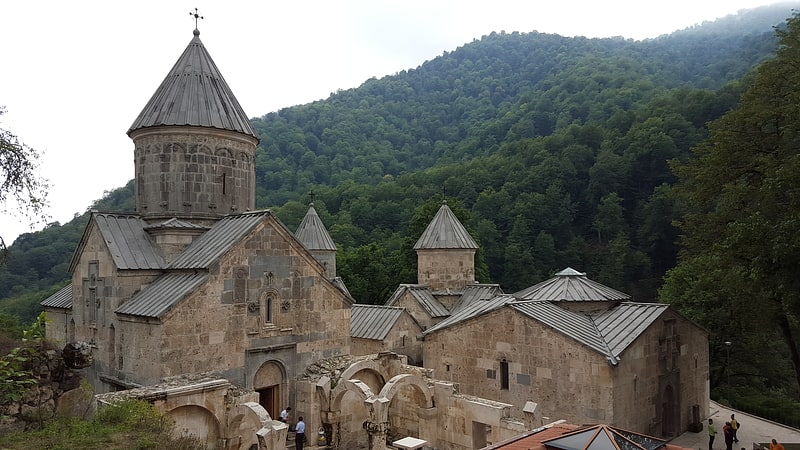
Also known as: Հաղարծնի վանք
Monastery in Armenia. Haghartsin is a 13th-century monastery located near the town of Dilijan in the Tavush Province of Armenia. It was built between the 10th and 13th centuries; much of it under the patronage of the Bagratuni Dynasty.[21]
Vahramashen Church, Byurakan
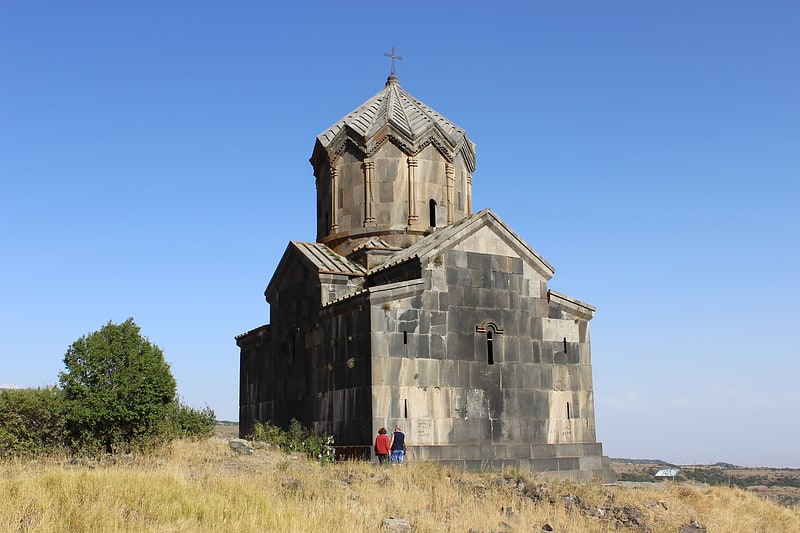
Also known as: Վահրամաշեն եկեղեցի
Armenian church in Armenia. The Vahramashen Church, also commonly referred to as Vahramashen Surp Astvatsatsin or the Church of Amberd) was built for Prince Vahram Pahlavuni of the Pahlavuni family. An inscription on the inside lintel of the north portal to the church dates its completion to the year 1026. It sits along the slopes of Mount Aragats in the Aragatsotn province of Armenia, between the fortress of Amberd and near a wall along the promontory with the Arkashian River in the canyon below.[22]
Fine Arts Museum, Vanadzor
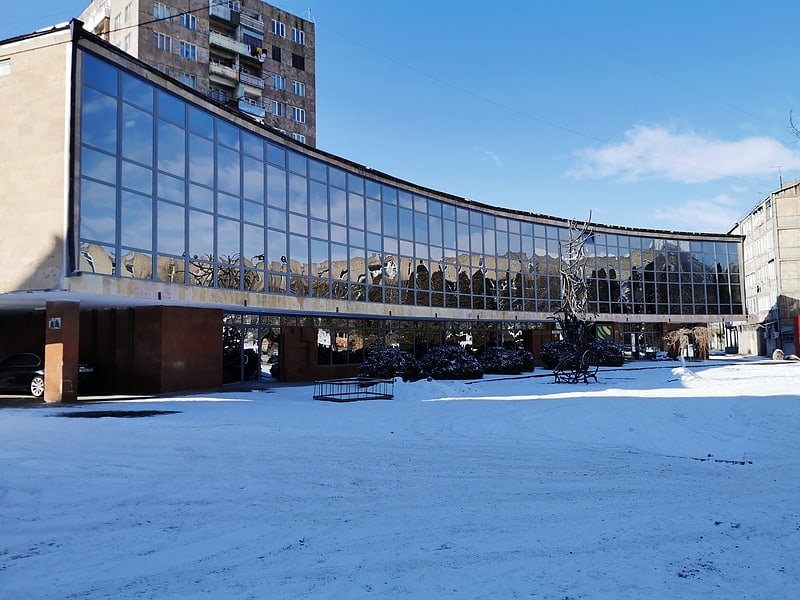
The Vanadzor Fine Arts Museum was founded in 1974 as a branch of the National Gallery of Armenia. Five years later, in 1979, museum authority transferred to the Kirovakan City Council, and in 2004 it was included in the Republic of Armenia's Historical and Cultural Monuments of Lori marz. Visitors can enjoy a variety works of art by Armenian artists, learn interesting stories about these artists, and discover something new about the rich cultural landscape of the Lori marz.[23]
Address: Tigran Mets St. 52, 2001 Vanadzor
Kobayr monastery, Alaverdi
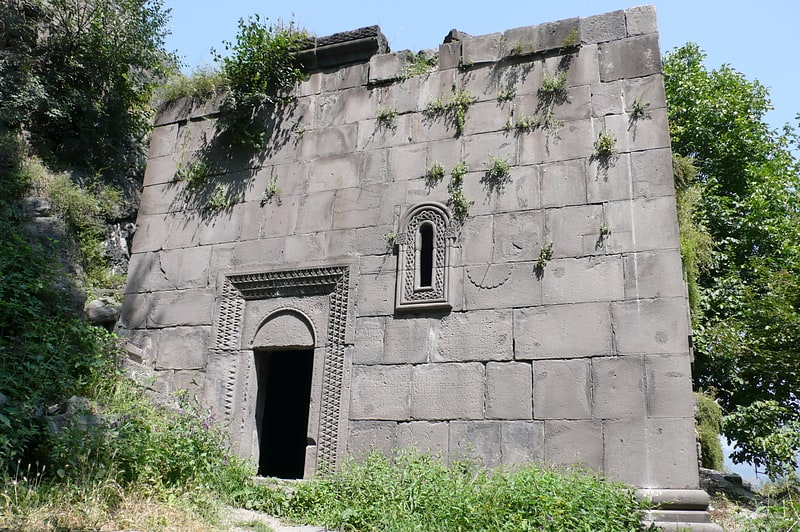
Also known as: Քոբայրի վանք
Monastery in Armenia. Kobayr is a 12th-century Armenian monastery located in the village Kobayr, directly across the road from the town of Tumanyan, within Lori marz, Armenia.
The monastery was built on a brink of a deep gorge, in 1171, by the Kyurikid princes, a junior branch of the Bagratuni royal house of Armenia.
In the 13th century, the monastery was acquired by the Zakarians, a noble Armenian dynasty at the service of Georgian royals. The Zakarians converted Kobayr into a Chalcedonian monastery, as a result of which the monastery stayed under the tutelage of the Georgian Orthodox Church for some time. This explains several Georgian inscriptions found on the walls of the monastery, which exist alongside the monastery's original Armenian inscriptions. The monastery houses the tomb of Prince Shanshe Zakarian, son of Ivane Zakarian. A bell tower in the middle of the complex was built in 1279 to house the tombs of Zakarian and his wife Vaneni. The monastery is currently undergoing renovation funded by the government of Armenia with the assistance of the government of Italy. The ruins of the main church in the monastery contain frescoes of Christ and the twelve apostles as well as the Church Fathers and other Christian figures.[24]
Address: Kobayr Monastery Road, Alaverdi
Ughtasar Petroglyphs, Sisian
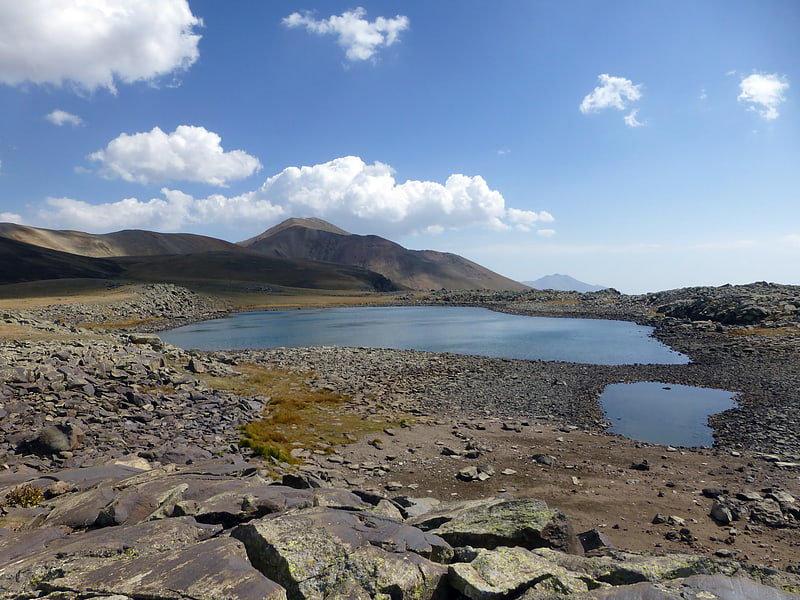
Historical landmark in Armenia. The Ukhtasar Petroglyphs are rock-carvings found on Mount Ukhtasar "Pilgrim Mountain", near the town of Sisian in Armenia's southern province of Syunik.
Over 2,000 decorated rock fragments extend to the foot of the mountain. These petroglyphs, some believed to date back to the Paleolithic, are carved onto dark brownish-black volcanic stones left behind by an extinct volcano. Later Chalcolithic and Bronze Age cultures continued to create petroglyphs at the site; "the largest variety and number of carvings date to this period and the early Iron Age, before it was finally abandoned except for a few carvings made by lonely shepherds spending their summers on the mountain top." Although the site was discovered in the early 20th century, it was not really studied until the 1920s and again in the late 1960s; it is still not fully understood today.
The carvings on the rock fragments depict hunting scenes, a wide array of animals, spirals, circles and geometric shapes, and even zodiac signs. Research suggests that the area served as a temporary dwelling for nomadic cattle-herding tribes, and studies of the rock carvings indicate that they were in use for hundreds of years, with peoples of later eras adding their own engravings to the stones. According to the research of Hamlet Martirosyan, the pictograms of Ughtasar represent a writing system known as "goat writing" or "itsagir". Many scholars believe that this was due to the large number of goats drawn on the stones, but according to Martirosyan it is because in the ancient Armenian language, the words “goat” and “writing” were homonyms. They would use these homonyms to express concepts through pictures, thus the abstract concept of “writing” found its reflection in the representation of a goat, because the words for “writing” and “goat” sounded the same. Goats are a prevalent theme on the stones, possibly because the word “dig” in ancient Armenian meant goat and was close enough to “diq,” the ancient word for gods. By combining abstract signs with the images of animals and people in horizontal or vertical rows, prehistoric engravers were able to convey specific messages.
Reproductions of the petroglyphs, or rock engravings, of Ughtasar can be found all over Yerevan; they are inscribed onto silver jewelry, painted onto coffee cups, traced into hand-made pottery, and they adorn the walls of cafes. Reaching the petroglyphs of Ughtasar can be challenging.[25]